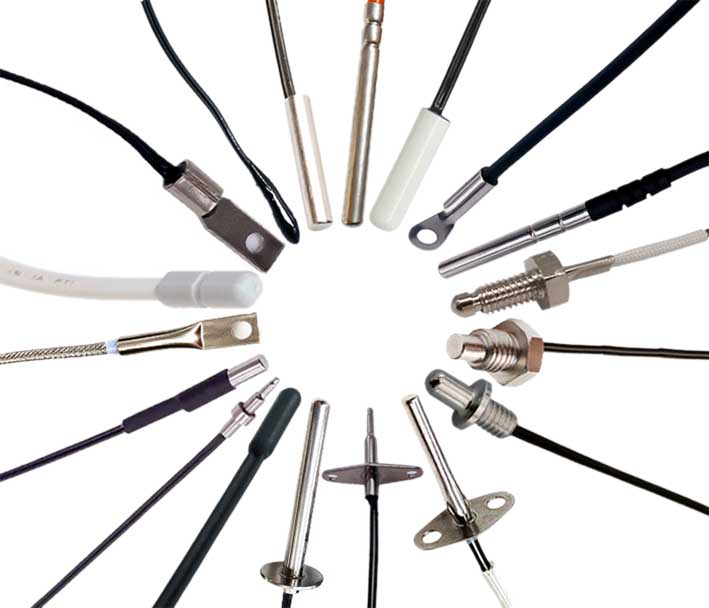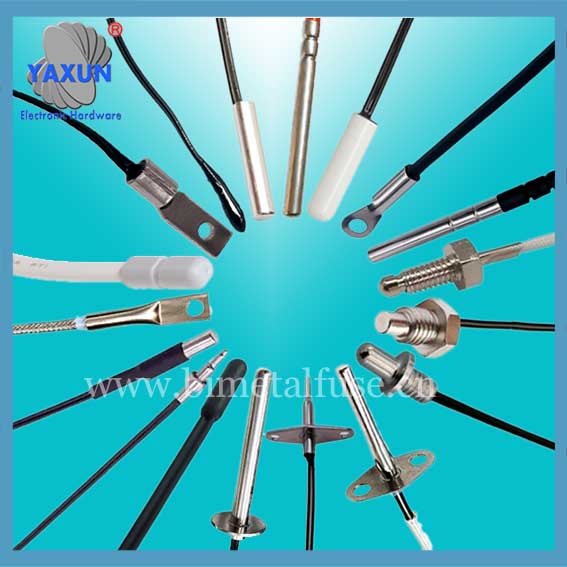catégories de produits
- fusion thermique 32
- fusibles à montage en surface 12
- thermistance 36
- Porte-fusible à montage sur circuit imprimé 27
- Faisceau de câblage 6
- Porte-fusibles à lame 17
- thermostat 50
- Fusible électrique 24
- Capteur de température automobile 7
- Disjoncteur thermique 22
- Porte-boîte à fusibles 36
- Capteur de température 75
- Interrupteur thermique 68
- Fusible de voiture 20
- Fusibles boulonnés 8
Mots clés du produit
Sonde et câble de capteur Ds18b20
Caractéristiques du capteur de température DS18B20: imperméable, anticorrosion.
Détails de l'' emballage: peut être personnalisé selon les besoins. MAXIM importé avec emballage d'origine; Paquet TO-92; grandes quantités en stock. Et fournir un capteur de température numérique DS18B20 dans un emballage étanche en tube d'acier inoxydable.
The ds18b20 temperature sensor probe has high accuracy. The temperature measurement accuracy can reach 0.01℃, and the temperature measurement accuracy in the wide temperature range is 0.1℃. Good stability and high precision in mass production.
The DS18B20 digital sensor probe and cable are easy to connect and can be used in a variety of situations after being packaged. Such as stainless steel straight pipe type, Type fileté, Type d'adsorption de l'aimant, divers modèles, y compris LTM8877, LTM8874 et ainsi de suite.
DS18B20 est un capteur de température numérique couramment utilisé. It outputs a digital signal and has the characteristics of small size, faible surcharge matérielle, strong anti-interference ability and high accuracy. Son apparence change principalement en fonction de l'application. Le DS18B20 encapsulé peut être utilisé pour la mesure de la température des câbles, mesure de la température de circulation de l'eau du haut fourneau, mesure de la température de la chaudière, mesure de la température de la salle des machines, mesure de la température des serres agricoles, mesure de la température en salle blanche, mesure de la température du dépôt de munitions et autres occasions de température non limite. Résistant à l'usure et aux chocs, petite taille, facile à utiliser, avec diverses formes d'emballage, il convient à la mesure numérique de la température et au contrôle de divers équipements de petits espaces.
Main features of DS18B20 sensor probe
1. Caractéristiques principales de DS18B20
1.1. The adaptable voltage range is wider, plage de tension: 3.0~5.5V, and can be powered by the data line in parasitic power mode
1.2. Méthode d'interface unique à un seul fil. Lorsque DS18B20 est connecté au microprocesseur, il n'a besoin que d'une seule ligne de port pour réaliser une communication bidirectionnelle entre le microprocesseur et le DS18B20.
1.3. DS18B20 prend en charge la fonction de réseau multipoint. Multiple DS18B20 can be connected in parallel on the only three lines to achieve multi-point temperature measurement.
1.4. DS18B20 does not require any external components during use. All sensing components and conversion circuits are integrated into an integrated circuit shaped like a triode.
1.5. Temperature range -55℃~+125℃, accuracy is ±0.5℃ at -10~+85℃
1.6. The programmable resolution is 9~12 bits, and the corresponding resolvable temperatures are 0.5℃, 0.25℃, 0.125℃ and 0.0625℃ respectively, which can achieve high-precision temperature measurement.
1.7. At 9-bit resolution, the temperature can be converted into numbers in up to 93.75ms. At 12-bit resolution, the temperature value can be converted into numbers in up to 750ms, which is faster.
1.8. The measurement results directly output digital temperature signals and are serially transmitted to the CPU via the "one-line bus". En même temps, the CRC check code can be transmitted, which has strong anti-interference and error correction capabilities.
1.9. Negative voltage characteristics: When the polarity of the power supply is reversed, the chip will not be burned due to heat, but it will not work properly.
2. Appearance and internal structure of DS18B20 sensor
The internal structure of the DS18B20 sensor mainly consists of four parts: 64-bit Photolithography Rom, capteur de température, non-volatile temperature alarm triggers TH and TL, and configuration register.
The appearance and pin arrangement of DS18B20 are as follows:
Définition des broches DS18B20:
(1) DQ is the digital signal input/output terminal;
(2) GND is the power ground;
(3) VDD is the input terminal of the external power supply (grounded in the parasitic power wiring mode).
3. Working principle of DS18B20
The reading and writing timing and temperature measurement principle of DS18B20 are the same as those of DS1820, except that the number of digits of the temperature value obtained is different due to different resolutions, et le temps de retard pendant la conversion de la température est réduit de 2 s à 750 ms. The oscillation rate of high temperature coefficient crystal oscillator changes significantly with temperature changes, et le signal généré est utilisé comme entrée d'impulsion du compteur 2. Comptoir 1 et le registre de température sont préréglés à une valeur de base correspondant à -55°C. Comptoir 1 compte à rebours le signal d'impulsion généré par l'oscillateur à cristal à coefficient de basse température. Lorsque la valeur prédéfinie du compteur 1 diminue à 0, la valeur du registre de température sera augmentée de 1, la valeur prédéfinie du compteur 1 sera rechargé, et compteur 1 recommencera à compter les signaux d'impulsion générés par l'oscillateur à cristal à coefficient de basse température. Ce cycle continue jusqu'à ce que le compteur 2 compte pour 0, puis arrête d'accumuler la valeur du registre de température. A cette époque, la valeur dans le registre de température est la température mesurée. The slope accumulator in Figure 3 is used to compensate and correct the nonlinearity in the temperature measurement process, et sa sortie est utilisée pour corriger la valeur prédéfinie du compteur 1.

ds18b20 sensor with accuracy up to 0.01℃

Sonde et câble de capteur DS18B20 personnalisés
DS18B20 a 4 main data components:
(1) The 64-bit serial number in the photoetched ROM is photoetched before leaving the factory. It can be regarded as the address serial code of the DS18B20. The arrangement of the 64-bit photolithography ROM is: le premier 8 morceaux (28H) are the product type number, and the next 48 bits are the serial number of the DS18B20 itself. The last 8 bits are the cyclic redundancy check code of the previous 56 morceaux (CRC=X8+X5+X4+1). The function of photolithography ROM is to make each DS18B20 different, so that multiple DS18B20s can be connected to one bus.
(2) The temperature sensor in DS18B20 can complete the measurement of temperature. Take 12-bit conversion as an example: it is provided in the form of 16-bit sign-extended two's complement reading, expressed in the form of 0.0625°C/LSB, where S is the sign bit.
This is the 12-bit data obtained after 12-bit conversion, which is stored in two 8-bit RAMs of 18B20. Le premier 5 bits in binary are the sign bits. Si la température mesurée est supérieure à 0, ces 5 Les bits sont 0. Multipliez simplement la valeur mesurée par 0.0625 Pour obtenir la température réelle. Si la température est inférieure à 0, ces 5 Les bits sont 1, and the measured value needs to be inverted, plus 1, puis multiplié par 0.0625 Pour obtenir la température réelle. Par exemple, the digital output of +125℃ is 07D0H, the digital output of +25.0625℃ is 0191H, the digital output of -25.0625℃ is FE6FH, and the digital output of -55℃ is FC90H.
(3) DS18B20 temperature sensor memory DS18B20. The internal memory of the temperature sensor includes a high-speed scratchpad RAM and a non-volatile electrically erasable EEPRAM, which stores the high-temperature and low-temperature flip-flops TH, TL and structural registers.
(4) Configuration register The meaning of each bit of this byte is as follows:
Tableau 3: Configuration register structure
The lower five bits are always "1", and TM is the test mode bit, which is used to set whether the DS18B20 is in working mode or test mode. This bit is set to 0 when DS18B20 leaves the factory, and users should not change it. R1 and R0 are used to set the resolution, as shown in the following table: (DS18B20 is set to 12 embouts à l'expédition de l'usine)
Tableau 4: Temperature resolution setting table
4. High-speed temporary storage memory The high-speed temporary storage memory consists of 9 octets, and its allocation is shown in Table 5. When the temperature conversion command is issued, the converted temperature value is stored in the 0th and 1st bytes of the cache memory in two-byte complement form. The microcontroller can read this data through the single-wire interface. When reading, the low bit is in front and the high bit is in the back. The data format is shown in Table 1. Corresponding temperature calculation: When the sign bit S=0, directly convert the binary bit to decimal; when S=1, first convert the complement to the original code, and then calculate the decimal value. Tableau 2 shows some of the corresponding temperature values. The ninth byte is the redundancy check byte.
Tableau 5: DS18B20 temporary register distribution
According to the communication protocol of DS18B20, the host (single chip microcomputer) must go through three steps to control DS18B20 to complete temperature conversion: DS18B20 must be reset before each read and write. Une fois la réinitialisation réussie, a ROM command is sent, and finally a RAM command is sent, so that the predetermined operation can be performed on the DS18B20. Reset requires the main CPU to pull the data line down for 500 microseconds and then release it. When DS18B20 receives the signal, it waits for about 16 à 60 microsecondes, and then sends out a low pulse of 60 à 240 microsecondes. The main CPU receives this signal to indicate successful reset.
Tableau 6: ROM instruction list
Contactez-nous
En attente de votre email, nous vous répondrons dans les 12 heures avec des informations précieuses dont vous aviez besoin.
 English
English Afrikaans
Afrikaans العربية
العربية বাংলা
বাংলা bosanski jezik
bosanski jezik Български
Български Català
Català 粤语
粤语 中文(简体)
中文(简体) 中文(漢字)
中文(漢字) Hrvatski
Hrvatski Čeština
Čeština Nederlands
Nederlands Eesti keel
Eesti keel Suomi
Suomi Français
Français Deutsch
Deutsch Ελληνικά
Ελληνικά हिन्दी; हिंदी
हिन्दी; हिंदी Magyar
Magyar Bahasa Indonesia
Bahasa Indonesia Italiano
Italiano 日本語
日本語 한국어
한국어 Latviešu valoda
Latviešu valoda Lietuvių kalba
Lietuvių kalba македонски јазик
македонски јазик Bahasa Melayu
Bahasa Melayu Norsk
Norsk پارسی
پارسی Polski
Polski Português
Português Română
Română Русский
Русский Cрпски језик
Cрпски језик Slovenčina
Slovenčina Slovenščina
Slovenščina Español
Español Svenska
Svenska ภาษาไทย
ภาษาไทย Türkçe
Türkçe Українська
Українська اردو
اردو Tiếng Việt
Tiếng Việt

